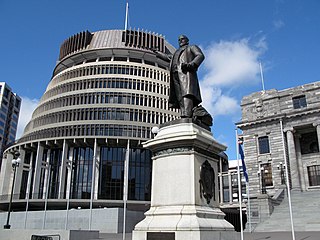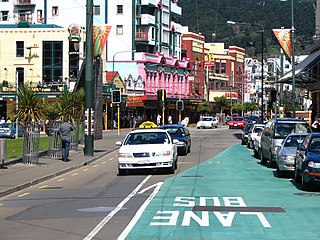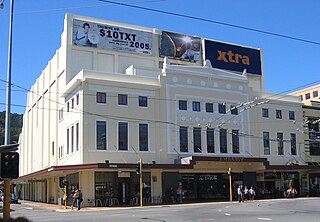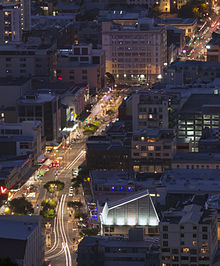
Wellington is the capital city of New Zealand. It is located at the south-western tip of the North Island, between Cook Strait and the Remutaka Range. Wellington is the third-largest city in New Zealand, and is the administrative centre of the Wellington Region. It is the world's southernmost capital of a sovereign state. Wellington features a temperate maritime climate, and is the world's windiest city by average wind speed.

Te Motu Kairangi / Miramar Peninsula is a large peninsula on the southeastern side of the city of Wellington, New Zealand. It is located at the entrance to Wellington Harbour, in Wellington's eastern suburbs. According to Māori legend, it was formed when the taniwha Whaitaitai beached as he tried to escape the confines of the harbour. It contains the suburbs of Miramar, Seatoun, Strathmore Park, and Karaka Bays.

Lambton Quay is the heart of the central business district of Wellington, the capital city of New Zealand.

Brooklyn is a suburb of Wellington, the capital city of New Zealand, under the governance of Wellington City Council. It lies 3 km south of Wellington's central business district on the eastern slopes of the hills above Happy Valley. It is located to the south of Aro Valley and Highbury, west of Mount Cook, north of Vogeltown, Mornington and Ōwhiro Bay and east of Kowhai Park, Panorama Heights, Mitcheltown and Karori.

The Aro Valley forms a small inner-city suburb of Wellington in New Zealand. It takes its name from the stream which originally flowed where modern Epuni Street is. The stream's Māori name was originally Wai-Mapihi, but it was commonly called Te Aro Stream due to it running through the Te Aro flat.

Heritage New Zealand Pouhere Taonga is a Crown entity with a membership of around 20,000 people that advocates for the protection of ancestral sites and heritage buildings in New Zealand. It was set up through the Historic Places Act 1954 with a mission to "...promote the identification, protection, preservation and conservation of the historical and cultural heritage of New Zealand" and is an autonomous Crown entity. Its current enabling legislation is the Heritage New Zealand Pouhere Taonga Act 2014.

Te Aro is an inner-city suburb of Wellington, New Zealand. It comprises the southern part of the central business district including the majority of the city's entertainment district and covers the mostly flat area of city between The Terrace and Cambridge Terrace at the base of Mount Victoria.

Cuba Street is a prominent city street in Wellington, New Zealand. Among the best known and most popular streets in the city, the Cuba precinct has been labelled Wellington's cultural centre, and is known for its high-per-capita arts scene the world over.

The Te Aro Extension, also known as the Te Aro Branch, was a short branch line railway in Wellington, New Zealand continuing the Wairarapa Line southwards. It operated from 1893 until 1917.

The St. James Theatre is a large proscenium stage theatre in central Wellington, New Zealand, and home to the Royal New Zealand Ballet. The building was designed in 1912 by New Zealand-born theatre designer Henry Eli White. It is located on Courtenay Place, the main street of Wellington's entertainment district, opposite the Reading Cinema complex.

The Embassy Theatre is a cinema in Wellington, New Zealand, located at the Eastern end of Courtenay Place in the shadow of Mount Victoria. Originally built in 1924, the building has undergone a series of remodellings and changes in ownership. It is currently owned by the Wellington City Council and temporarily administered by the Embassy Theatre Trust. Management rights were sold to SKYCITY Cinemas in October 2005, and is now part of AHL owned Event Cinemas. The building is recognised as a place of historical/cultural significance by Heritage New Zealand and is the only custom-built 1920s cinema still in use in New Zealand.

Ngā Taonga Sound & Vision is an archive that was launched on 31 July 2014, following the completion of a three-year process whereby the New Zealand Film Archive "absorbed" the collections and operations of the RNZ Sound Archives Ngā Taonga Kōrero in 2012 and the Television New Zealand Archive in 2014.

The Ministry for Culture and Heritage is the department of the New Zealand Government responsible for supporting the arts, culture, built heritage, sport and recreation, and broadcasting sectors in New Zealand and advising government on such.

The Wellington Inner City Bypass is a westbound one-way road varying from two to four lanes largely at ground level in central Wellington, New Zealand, part of State Highway 1, and was fully opened in March 2007.
William Fielding was a New Zealand architect who practised in Wellington. He was also a bowls player, winning two medals at the 1930 British Empire Games.

Puke Ariki is a combined museum and library at New Plymouth, New Zealand which opened in June 2003. It is an amalgamation of the New Plymouth Public Library and the Taranaki Museum. Its name, Māori for "hill of chiefs", is taken from the Māori village that formerly occupied the site.

Te Aro railway station was a station in Wellington, New Zealand, near what is now the corner of Wakefield and Tory Streets. Opened in 1893 it was one of only three stations in the city - the other two were Wellington railway station on Featherston Street, renamed Lambton railway station in December 1908, which was the main New Zealand Railways Department station, and Thorndon railway station off Thorndon Quay, the southern terminus of the private Wellington and Manawatu Railway.

Thomas Turnbull (1824–1907) was a notable New Zealand architect.

The Hannah Playhouse is a theatre venue situated on the corner of Courtenay Place and Cambridge Terrace in central Wellington, New Zealand. The Hannah Playhouse was given by Sheilah Winn and named after her grandfather, Robert Hannah, a very successful businessman. It was carefully designed and built to house Downstage Theatre.

New Zealand performing arts venues are places in New Zealand that are set up to host performing arts and music events such as theatre, dance and concerts.

































